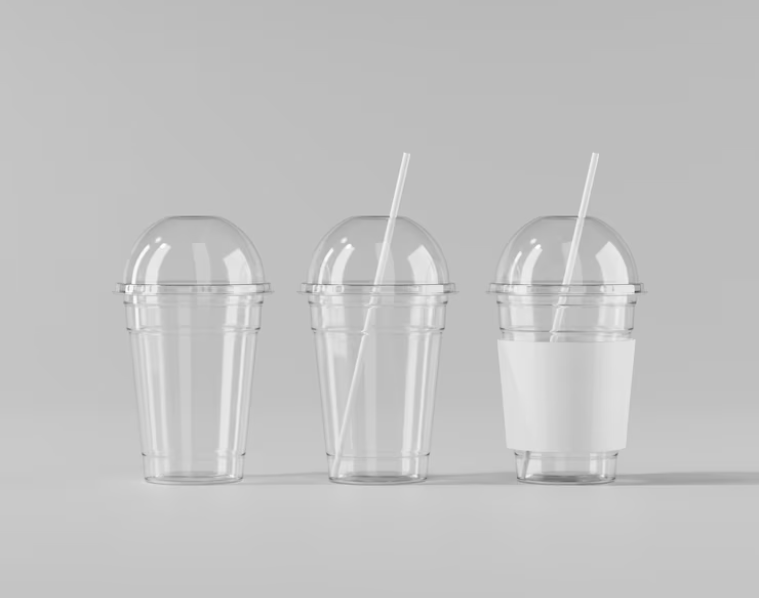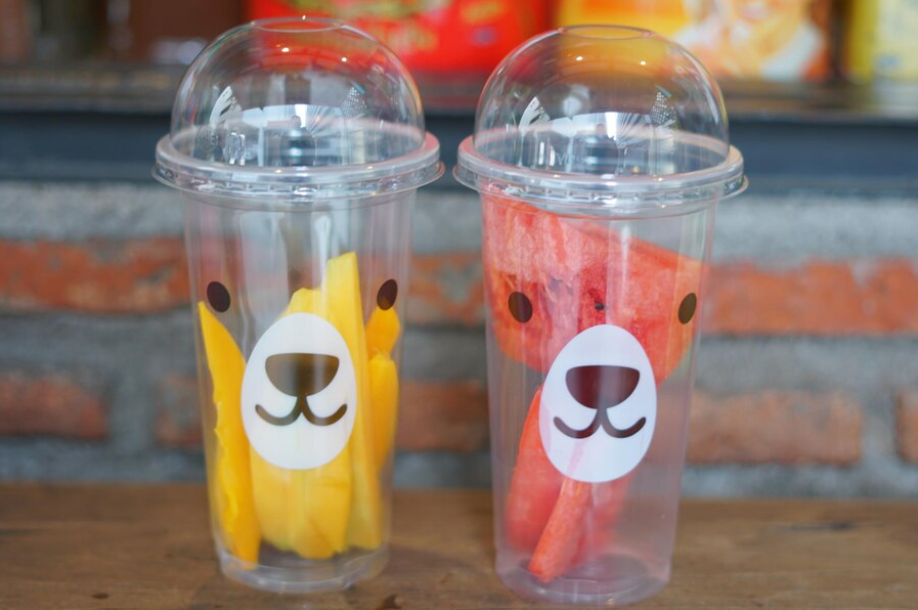
지금 문의하기
PET 컵 대 PP 컵: 어느 것이 더 낫나요?
많은 구매자가 적합한 옵션을 찾기 위해 "PET vs. 폴리프로필렌"을 검색하거나 "PP vs. PET 플라스틱 컵"을 궁금해합니다. 이 블로그에서는 PET와 PP 플라스틱을 비교하고 장단점을 분석한 후, "PET 컵 vs. PP 컵 - 어느 것이 더 나을까?"라는 질문에 대한 답을 제시합니다.

플라스틱 컵은 다양한 형태로 출시되어 다양한 필요와 선호도를 충족합니다. 세 가지 주요 유형은 다음과 같습니다.
- 플라스틱 컵(화석 연료로 제조): 석유와 같은 화석 연료에서 추출한 폴리머로 제작된 이 컵은 시중에서 가장 널리 사용되는 제품입니다. 편리함과 안정성을 제공하여 다양한 음료 제공에 필수적인 선택입니다.
- 생분해성 플라스틱 컵: 올바르게 폐기하면 자연적으로 분해되도록 설계된 생분해성 플라스틱 컵은 환경적 지속가능성에 기여합니다. 이 카테고리는 친환경 대체품에 대한 증가하는 수요에 발맞춰 책임감 있는 폐기 관행을 강조합니다.
- 플라스틱 퇴비화 컵: 이 컵은 산업적 변형 과정을 거쳐 유기 비료로 전환됩니다. 이 혁신적인 접근 방식은 폐기물 감소와 순환 경제 촉진에 기여하며, 환경적 책임에 대한 기업의 헌신을 보여줍니다.
플라스틱 컵은 다양한 형태로 나오지만, 가장 흔한 두 가지 유형은 폴리에틸렌 테레프탈레이트(PET)와 폴리프로필렌(PP)입니다. PET는 투명도가 높아 투명 컵에 자주 사용되는 반면, PP는 견고하여 불투명 용기에 자주 사용됩니다.
PET 플라스틱의 장단점
일반적으로 PET 플라스틱으로 알려진 폴리에틸렌 테레프탈레이트는 여러 가지 장점을 가지고 있습니다. 가벼워 휴대가 간편하고, 투명하여 내용물을 쉽게 확인할 수 있습니다. 또한, PET는 재활용이 가능하여 환경 지속가능성에 기여합니다. 하지만 PET에도 단점이 있다는 점을 알아두는 것이 중요합니다. 다른 플라스틱에 비해 내열성이 낮아 뜨거운 음료에는 적합하지 않을 수 있습니다. 또한, 일부 대체 플라스틱만큼 견고하지 않을 수도 있습니다.
PET와 PP 플라스틱 컵의 차이점은 무엇인가요?
일회용 컵을 찾는 많은 사람들은 따뜻한 음료나 차가운 음료에 적합한 소재를 파악하기 위해 "PP 대 PET" 또는 "폴리프로필렌 대 PET"를 구체적으로 비교합니다. 폴리프로필렌(PP)과 폴리에틸렌 테레프탈레이트(PET) 플라스틱의 차이점을 이해하면 각 유형이 다양한 용도에 적합한 고유한 특성을 파악할 수 있습니다.
폴리프로필렌(PP) 컵
이것들은 특히 식품 서비스 산업에서 간단히 "PP 플라스틱 컵" 또는 "PP 컵"이라고 불리는 경우가 많습니다.
- 다재다능하고 견고함: PP 컵은 다재다능하고 내구성이 뛰어나 일회용 컵으로 널리 사용됩니다.
- 뛰어난 투명도: 뛰어난 투명도로 유명한 PP 컵은 소비자가 내용물을 선명하게 볼 수 있어 생동감 넘치는 음료나 층이 있는 음료에 이상적입니다.
- 내열성: PP 컵은 따뜻한 음료와 차가운 음료를 모두 담을 수 있어, 식품 서비스 산업에서 필수적인 소재입니다.
- 강도: 튼튼하고 깨지기 어려운 PP 컵은 바쁜 시설에서 신뢰할 수 있는 선택이며, 사고와 유출을 방지하는 내구성을 보장합니다.
- 재활용성: 일반적으로 재활용이 가능한 PP 컵은 재활용 프로그램에서 PP 플라스틱을 점점 더 많이 수용함에 따라 환경 친화성에 기여합니다.
- 누수 방지: 누수와 유출을 방지하도록 설계된 PP 컵은 탄산 음료를 포함한 다양한 음료에 적합합니다.
폴리에틸렌 테레프탈레이트(PET) 컵
소비자들은 투명한 콜드드링크 컵을 선택할 때 "펫 대 PP 플라스틱"과 같은 용어를 검색하는 경우가 있습니다.
- 투명하고 가벼움: PET 컵PP 컵처럼 투명도가 뛰어나 내용물이 잘 보입니다. 가벼워 운반 및 취급이 편리하며, 행사나 모임에 자주 사용됩니다.
- 재활용성: PET 컵은 재활용이 널리 허용되며, 새로운 PET 용기와 의류용 섬유 등 다양한 제품으로 변형될 수 있습니다.
- 균열 방지: PET 컵은 다른 플라스틱 컵에 비해 균열이 잘 생기지 않아 다양한 음료를 담기에 안정적인 옵션입니다.
- 비용 효율성: PET 컵은 종종 비용 효율적이어서 대량의 컵이 필요한 기업에 실용적인 선택입니다.
PET의 투명성과 재활용성은 또한 글로벌 테이크아웃 붐에서의 역할을 촉진했습니다. PET 컵이 2025년 테이크아웃 문화를 형성하는 방식 최근의 통찰력을 보려면.
PET 컵과 PP 컵의 최종 선택은 결국 사용자의 필요에 달려 있습니다. 투명성과 재활용성을 중시한다면 PET 컵이 정답입니다. 차가운 음료를 담기에 적합하며 내용물을 맑고 투명하게 볼 수 있습니다. 반면, 내구성과 내열성이 중요하다면 PP 컵이 더 나은 선택입니다. 불투명한 PP 컵은 따뜻한 음료나 견고함이 중요한 상황에 적합합니다.
PP 플라스틱을 식별하는 방법?
폴리프로필렌 플라스틱을 식별하는 것은 생각보다 쉽습니다. PP 플라스틱에는 종종 재활용 코드 "5"가 붙어 있는데, 이는 재활용 분류를 나타냅니다. 또한, PP는 반경직성과 내화학성으로 잘 알려져 있습니다. 만약 의심스럽다면 재활용 코드를 확인하고 플라스틱의 질감을 직접 느껴보세요.
PET 플라스틱을 식별하는 방법?
폴리에틸렌 테레프탈레이트(PET) 플라스틱은 투명하고 매끄러운 질감으로 유명합니다. 일반적으로 재활용 코드 "1"과 함께 사용됩니다. PET는 가벼워서 일회용 음료 용기로 사용하기에 매우 적합합니다. 의심스러우면 재활용 코드를 확인하고, 플라스틱이 투명하고 가볍다면 PET일 가능성이 높습니다.
자주 묻는 질문
PP컵과 PET컵의 차이점은 무엇인가요?
PP 컵은 높은 열을 잘 견디고 튼튼하며, PET 컵은 차가운 음료를 담을 때 투명도가 뛰어납니다.
PET와 PP 중 어느 것이 더 낫나요?
맑고 차가운 음료를 원하시면 PET를 선택하세요. 내구성과 뜨거운 액체를 원하시면 PP를 선택하세요.
PP와 PET 중 어느 것이 더 비싼가요?
비용은 지역마다 다르지만, 대량 주문 시에는 PET가 약간 더 저렴합니다.
PET컵은 안전한가요?
네, PET는 식품 등급이며 널리 재활용되지만 고온의 액체는 피하세요.
PP 컵을 뜨거운 물에 사용할 수 있나요?
네. PP 컵은 끓는 물과 뜨거운 커피를 담을 수 있습니다.
플라스틱 컵에 PP는 무엇을 의미하나요?
PP는 폴리프로필렌을 뜻하며, 강하고 내열성이 강한 플라스틱입니다.
"PET컵"은 무슨 뜻인가요?
투명성과 가벼운 무게로 유명한 폴리에틸렌 테레프탈레이트로 만든 컵입니다.
결론
PP와 PET 플라스틱 컵 중 어떤 것을 선택할지 고민할 때, 개인의 필요와 우선순위를 고려하는 것이 중요합니다. PET의 투명도나 PP의 견고함 중 어떤 것을 선택하든, 결정은 개인의 구체적인 요구 사항에 맞춰야 합니다. 이러한 상황에서, 그레이스는 기능성과 환경 의식을 모두 갖춘 PET 컵과 PET 뚜껑을 제공하며 업계를 선도하는 기업으로 자리매김하고 있습니다. 끊임없는 혁신과 최고를 향한 헌신을 바탕으로, Jinkai는 최고의 PET 컵을 제공하기 위해 끊임없이 노력하며 모든 일회용 식기류에 대한 명확하고 지속 가능한 선택을 보장합니다.

